The Importance of Wearing Socks – Should Kids Wear Socks with Grippers or No Grippers?
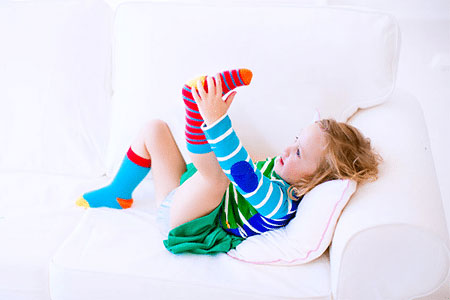
Are your kids always refusing to wear socks with their shoes? Are you tired of having a battle every morning when you try to put your child’s socks on? The importance of wearing socks is clear: They help prevent the formation of blisters and the build-up of bacteria inside the shoes. Socks also help protect your children’s feet from getting foot infections.
I have put together a selection of the best kids’ socks in terms of comfort, materials, and durability. Before you provide your child with a pair of socks, you need to know whether the socks should come with or without grippers on the bottom.
The Importance of Wearing Socks – Grippers or No Grippers?
If your little ones are walking barefoot around the house —as recommended for healthy foot development— they are going to need a pair of socks to protect their feet from the cold.
Have you noticed how some socks come with grippers on the bottom? If you don’t know what I mean by “gripper socks”, take a look at the picture below which shows a pair of kids’ socks with grippers on them:
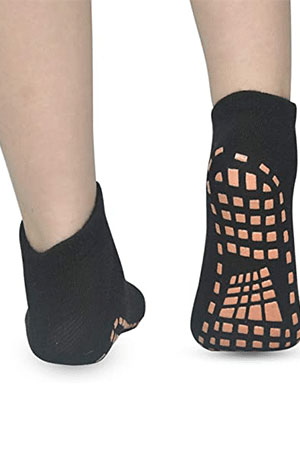
Children should only wear socks with grippers when they are not wearing shoes. The main reason for this is that the grippers will stick to the insoles of the shoes, preventing your child’s feet and toes to move freely. Babies and toddlers move their toes as a way of exercising their feet, that’s the reason why it’s so important to not constrict this toe movement. If your child’s toes are cramped inside the shoes, this can also lead to the formation of blisters.
If your children are not wearing shoes, like when they are walking inside the house, you can definitely provide them with socks that come with grippers, as they will provide your children with better stability and prevent them from falling.
Gripper socks are ideal for babies or toddlers who are learning how to walk. The grippers will help make your toddler feel more stable when walking.
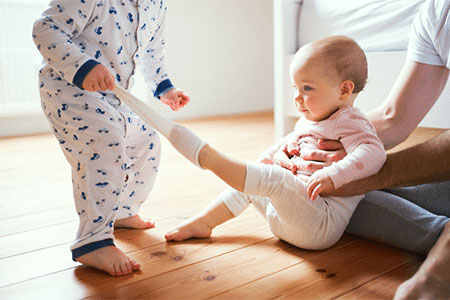
What Fabrics Should Socks Be Made of? – Let’s Find Out!
When looking for your kids’ socks, it’s critical that you always take into account the type of fabric used. The fabric will have an impact on both the comfort and durability of the sock.
The most common and popular fabric is cotton. However, this doesn’t mean that cotton is the best fabric for your kids’ socks. While cotton allows the foot to breathe and it tends to absorb moisture, it doesn’t dispel it. This means that your child might walk around for longer periods of time with socks that are damp.
The 3 most recommended sock fabrics are:
1️⃣ Merino Wool
2️⃣ Acrylic
3️⃣ Bamboo
These fabrics dispel moisture and allow your child’s feet to stay dry during the day.
Are Seamless Socks Better Than Regular Socks?
Seamless socks are highly recommended for foot comfort especially for children who have sensitive feet, another name for this type of sock is hand linked seams.
Some children feel every bump and lump as soon as they put their socks on. If this is the case with your child, you need to find a pair of seamless socks and you will notice they make a tremendous difference in how the socks feel on your kids’ feet.
I also always recommend parents look for seamless socks since they are great for children who struggle with “bumps” and “lumps”.
Certain socks claim to be seamless but they are actually not 100% seamless. I will make things easier for you and provide you with a selection of the best kids’ socks that are seamless, comfortable, provide good cushioning and dry reasonably fast.
The Importance of Wearing Socks
The benefit of wearing socks is clear, they play a key role in keeping your kids’ feet healthy. However, if the socks are not comfortable or the correct size, your child will refuse to wear them.
I always explain to parents that getting the correct sock size has the same importance as getting the correct shoe size.
If the socks are fitted too short, they will end up constricting your kids’ toe movement and make your kids’ toes overlap and rub against each other —this can lead to blisters— On the other hand, if the socks are fitted too long, they will end up bunching up below your kids’ feet and your child will feel uncomfortable and refuse to wear them.
How to Get the Correct Sock Size for Your Child? – Get It Right!
You should always ignore the label that reads “sock size” or “age guidelines”. To provide your child with the correct sock size, you must always look under the label “shoe size” in the socks’ tags. This is the most effective way to find your child’s correct sock size. Take a look at the image below for clarification:
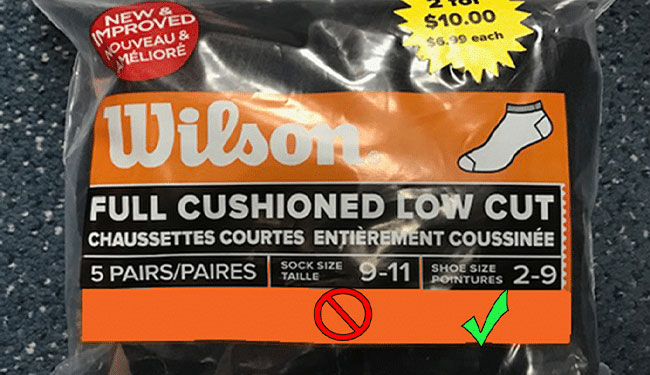
If the socks that your child is currently wearing are too large, the excess should be folded up over the toes (not under the toes) since this will allow the socks to adjust to the proper fit as the foot moves inside the shoe. However, there is no reason for your child’s socks to be too large now that you know how to get the correct sock size for your child.
Socks separate your kids’ feet from the shoe and help avoid irritation and infections, but they also help parents realize if their children’s feet are sweating too much. Without socks, parents wouldn’t know whether their children’s feet are sweating excessively. Switch your kids’ socks twice a day if your child’s feet tend to sweat a lot.
What Are the Best Socks for Kids with Sweaty and Smelly Feet?
With your child in school all day and leading an active life, you want socks that wick away moisture instead of retaining it. A moisture-wicking fabric has two jobs: one is quickly wicking (moving) sweat to the fabric’s outer surface and the other is drying quickly.
Sweaty feet is an issue that spans all age groups. The best way to deal with sweaty – and in some cases—stinky feet is by wearing the correct type of socks. Even if your kids’ feet are not prone to sweating excessively, moisture on the skin can create a myriad problems, such as blisters, the growth of odor-causing bacteria, and fungus, such as Athlete’s Foot.
Synthetic socks are the worst since they don’t dispel moisture nor allow the foot to properly breathe. A little synthetic fiber it’s okay, but I advise against synthetic materials if your kids’ feet sweat too much. Cotton is a wonderful fiber, however, it does not dispel moisture as well as other fibers.

I have put together a selection of children’s socks that are seamless, durable, and breathable. These socks will keep your kids’ feet healthy and prevent blisters, the buildup of bacteria inside the shoes, and foot infections.
I only write reviews of shoes and socks that I have fitted before, so I can personally assess how well-made they are and how well they fit. Disclosure: Some links in this post may be affiliate links and we may receive a small commission (at no extra cost to you) when you click our links and make purchases. This allows us to create free content and resources for many families around the world.
The Best Kids’ Socks
Baby Sizes
- Socks made by Epeius
- 76% combed cotton, 21% polyester and 3% spandex
- Seamless cable/ribbed knit knee high socks for babies
- Breathable
- Machine wash
- Socks made by SeriSimple
- Smooth toe seam provides less irritation and bulk for sensitive toes and feet
- Made of 82% bamboo and 18% elastane
Toddlers and Older Children Sizes
- Socks made by Rambutan
- Made with premium bamboo (naturally moisture wicking)
- Seamless
- Machine wash
- Socks made by SeriSimple
- Made with premium bamboo (naturally moisture wicking)
- Seamless
- Machine wash
- Socks made by SilkyToes
- 80% Rayon from Bamboo, 10% Polyester, 5% Nylon, 5% Spandex
- Cushioned sole to keep your child’s feet comfortable
- Machine wash
- Socks made by Bamboo Sports
- Made with premium bamboo (naturally moisture wicking)
- Soft and durable
- Socks made by SeriSimple
- Premium breathable,super soft and comfortable fabric
- Medium thickness suitable for all seasons
- Machine wash
- Socks made by SilkyToes
- Bamboo socks are naturally moisture wicking so that your child’s feet stay dry
- Cushioned sole to keep your child’s feet comfortable
- Machine wash
Please don’t hesitate to contact me if you are having trouble finding a particular shoe or sock style for your child.
Is there a particular sock brand or sock style that has worked well for your child’s feet? Please share your findings in the comments below so other parents can benefit from your experiences.










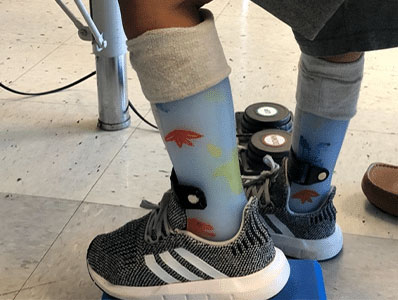
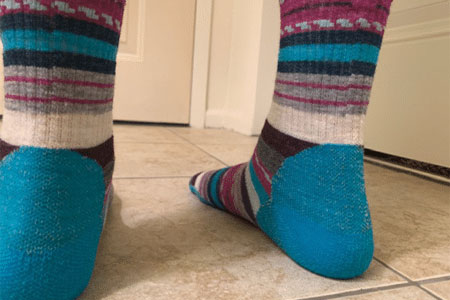
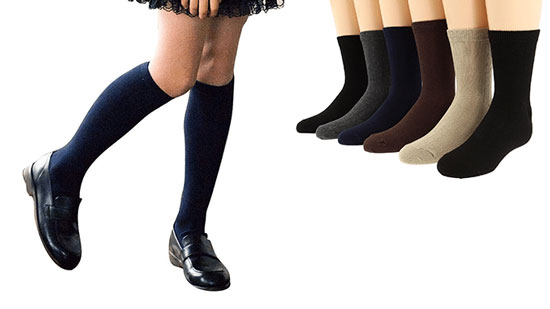
It’s great that you mentioned how socks could help protect children’s feet from getting foot infections. Our son outgrew his current socks so now we need to buy him new sets. I heard some shops could even let you design your own socks, so I am thinking of looking into that.
Hello Luke,
That sounds great, just make sure those shops manufacture high-quality and seamless socks.
Thanks for sharing these really helpful tips! Please keep sharing more
I am glad that you find the website informative!
Wow – I had no idea that this much went into socks. It makes sense though that they are meant to protect the feet from unwanted issues and such. Thanks for bringing this to my attention.
Socks play a huge role in keeping our kids feet healthy and comfortable. Wearing the right sock has the same importance as wearing the correct shoe size! If your child has a wide foot for example, there are particular socks that will fit his feet better. Take a look at this post:
Socks for Wide Feet – The Best Wide Socks for Kids
As I am quite an active person, what with work and daily life I worry about sweaty feet. And also the added health issues with this. I didn’t know though that there were socks that could help with this so this post was quite useful for me. I think that I will try the UnderArmour socks. Do you know where I could get some? Are they on Amazon?
Owain,
Did you know that there are various reasons why your feet might be sweating excessively? Smelly feet is commonly brought on by emotional stress or physical exercise. However, they type of socks and footwear that you use can and will reduce the amount of sweat. The UnderArmour socks are one of the best and Amazon is the cheapest place to buy them from.
Saludos, Juan Pablo!
Glad to be back on your website.
Interesting article, must I say. I haven’t really thought about socks in such a deep way as you present it here.
I remember my parents always making me wear socks around the house (which I hated) but they were right – wearing socks around the house with cold floors definitely wouldn’t be beneficial for the child. Not sure if they thought of the material of the socks, but nowadays I choose socks by the way they feel on my feet. I like a soft material, feels nice on the feet.
There were a lot of moments in your article that were new for me; as I said earlier, I didn’t really think much about socks in a deep way.
Oh well, every day we learn something new, no?
Thank you for sharing,
Zarina
Zarina,
I am glad that you found the article informative. Socks play a huge role when it comes to footwear. For example, children who are running around all day tend to sweat a lot, and if they don”t wear breathable shoes and socks then they will be more prone to foot issues. Sweaty feet is an issue that spans all age groups. The best way to deal with sweaty – and in some cases—stinky feet is to wear proper socks. Even if your feet are not prone to sweating excessively, moisture on the skin can create myriad problems, such as blisters, the growth of odor-causing bacteria, and fungus, such as Athlete’s Foot.
Ugh I have sweaty feet whenever I leave home from work no matter if the weather is hot or cold. Sometimes when you’re running around all day on a construction site you can get quite a bit of moisture in your shoes. I mean even when I pressure wash things at work I would have my wet shoes in the garage all night and they still would not be dry the next morning. I’ve had to throw out socks because they smelled so bad after work.
Good Stuff!
Chris
Chris,
I believe what you need is a pair of waterproof shoes or waterproof boots. If you wear them with a pair of wool socks you should definitely see an improvement. Sweaty feet can bring a myriad of problems and it must be very uncomfortable having to work with your feet being wet. I will be writing a post about waterproof shoes for men and hopefully you will find it useful.
Congrats on a clear and direct way of letting us know when the grippers are appropriate and when not.
You’ve mentioned that infants should wear grippers while walking barefoot around the house. I presume that this is meant during the colder periods only? We prefer walking barefoot – without socks – during late spring and through all of the summer.
Anyways, thanks for the info and good luck!
Ervin,
Infants should wear socks if it is cold inside the house. Maybe if there is tile floor or wood floors. Socks will also act as a barrier between the foot and the floor. If it is warm enough in the house walking barefoot without socks is totally fine.
I do like this website’s ideas. Because it is true: Walking barefoot is necessary for healthy foot development. Which is why I personally wear 5finger ‘barefoot’ shoes when I walk out in nature. Wearing a pair of gripper socks does sound like a better idea than wearing slippers around the house.
Graham,
Walking barefoot around the house allows the baby to promote healthy muscle development. The tiny toes are constantly wiggling, which is nature’s way of exercising the foot for development. Toe gripping is also essential for gait balance when the child starts to walk.
I have never tried the 5 finger “barefoot” shoes but I do know that some people swear by them. I actually prefer good supportive shoes for children or adults who are on their feet all day.
I tried the Dirty Buck and now I ordered some of the socks you recommend. My child doesn’t like to wear socks and he always has one that does not match the other.Once I read about the potential danger of not wearing socks such as irritation and infection, I knew it was time to get him new socks.
Thanks for pointing out the specific socks that is recommended for children to wear at home.I was gonna raise the slippery problem but you’re aware of that and cover it in your post.
It’s something new for me to know on sizes on sock tags. I appreciate with this particular tip. I will take note on that!
Tar,
I hope you have been happy with the Dirty Buck. All the socks I recommend are top of the line. Some of them are seamless socks, which children tend to love. I recommend them fr children who have wide feet or children who have sensory issues.
Which particular sock did you get? Please stay in touch and let me know how they work out.
Very interesting. I went through a period of not wearing socks, and my feet toughened up to it. This was probably only possible because I only wore shoes at work. This is really not such a smart idea .I never got foot fungus or the like, but I did get enough foreign objects in my feet, such as glass, to require surgery! This site teaches the value of socks, as well as what kinds of socks are best for different types, and ages of people. It would be wise to consult this site when choosing footwear. What kind of shoes do you wear? Investigate a sock that goes well with them. I’m sure I’m not the only one who has worn socks that slip down, bunch and cause blisters, feel too tight you name it… This site can help you find the answers to your footwear questions.
Sam,
Thank you for sharing your experience. As you mention in your comment, if we do not wear the right type and size sock it can cause many problems to our feet. Children are running around for most of the day which makes their feet more prone to sweating. Sweaty feet not only creates bad odors, but it also creates moisture on the skin that leads to a myriad of problems, such as blisters, and fungus, such as athlete’s foot.
Juan,
I learned a lot on your site just never gave it much thought as kids we just always wore socks.
I do think a lot about shoes since I had 7200 volts of electricity go through my body. The scares on my feet feel a lot better with the right shoes and possible the socks do make a difference.
Now in my yawning years I do like knee high socks for leg support.
Thanks for the great info.
Jim,
In all honestly, I never knew or understood the importance of proper fitting socks and shoes until I started working at the shoe store. I understand that most people are not aware of the problems we can create to our children’s feet or to ourselves by avoiding wearing socks, and I believe this is just due to people not being informed. The reason I created the website is to inform people about footwear and socks, that way they can make the most informative decision. You should try seamless socks to avoid any friction to your feet. You should also make sure that you are wearing shoes that are wide enough for your feet, since after the incident you had, you want to avoid any sort of pressure towards your feet.
I like the idea of children wearing gripper sock in the house. Why do you say they should not wear them with shoes?
Please clarify
Bruce,
If you child wears a gripper sock inside the shoe the grippers tend to stick to the bottom of the shoe, constricting foot movement. If the toes or the foot are not able to move then this can create blisters in the small toe. I hope this clarifies.
Great information! A lot of stuff I never knew about when buying socks.
Leticia,
I am glad you found my review informative. Socks play an important role in keeping our feet healthy since they act as a barrier between our feet and the shoes.
I came across your article as I Was looking for some socks for my daughter for school time as her feet were smelly when she got home. I didn’t realise the science behind it! I see you have suggested some socks which specifically help with smelly feet. Great stuff
Do you know if there is a special way that you should wash them or anything?
I do not believe there is a special way to wash them. Do keep in mind that they will shrink once you put them in the machine, so cold water is recommended. I hope after you try these socks your child won’t have smelly feet anymore! Thank you for sharing!
This was a very informative article. Though I have heard of the brand, I have never heard of UnderArmour socks before! I might have to invest in a pair of those! Wool socks are great to wear in our climate.
I agree, children need to wear socks! I hated the blisters I would get as a kid from rushing out the door without putting socks on.
Thank you for sharing!
Blisters are the worst, they can be very uncomfortable and painful. UnderArmour socks are highly recommended. Thank you for sharing!
It’s so hard to find good socks these days for kids.
The cheap nylon ones they sell in big department stores make my daughter’s feet sweat and she hates them!
The grippers are good when they are little especially walking on tiles in the kitchen. Helps to prevent slips!
I’ll check out the ones you recommend to get some better quality socks for my little terror!
Luke,
Thank you for sharing.You are correct that nowadays is hard to find good socks not just for our children, but for adults as well. You definitely should stay away from nylon socks. Look for cotton and wool. Tell me how everything works out!
Thanks for your review on socks for children as I believe it is very essential to the care of their feet and this should be a priority. Children can be very sensitive and if we are not cautious, it could lead to various circumstances such as feet problems.
I also appreciate the fact that you highlited the various kind of socks and their various use. That was much informative.
The whole purpose of providing our children with the proper pair of shoes and socks is to avoid and prevent any kind of foot injuries or problems. I am glad that you found the website informative.
Great post Juan! I had no idea that synthetic socks did not absorb moisture. I am a sufferer of sweaty feet. Under Armour is a great company and I am not surprised that they have done it again! I will be sure to spread the word. Have you tried out these sock yourself?
Evan,
Synthetic socks are the worst in that they do not absorb moisture nor allow the foot to properly breathe. A little synthetic fiber in your sock is not the end of the world, but I advise against synthetic materials if your feet sweat at any level of possible discomfort.Cotton is a wonderful fiber, however it does not absorb moisture as well as other fibers. The fibers that you can purchase socks in which absorb the most moisture, in order of absorption, are wool and merino. Let me know anytime you have any questions about footwear or hosiery.
I agree it’s definitely important to wear socks! However I had no idea there were so many different kinds or that it really made a difference which kind you wore. I’ve always thought a sock is a sock. It’s interesting reading through this and seeing your suggestions. With each type of sock you mention, it’d be useful to have a picture showing what that sock looks like. I have no idea what a gripper is but my boys are home all the time and I don’t like them to wear shoes in the house but they do wear their socks. I wonder how the grippers compare to what they usually wear. This is an interesting read and it’s obvious you know what you’re talking about!
Who would have thought that socks play such a key role in footwear? The importance of wearing socks is clear, since they play an important role in a healthy foot for children. Fabric content and fit are essential for comfort inside the shoe. You should take a look at this resource: The Best Seamless Socks for Toddlers – Breathable, Comfortable, and Durable!
Dear Juan,
I always wondered why my mom felt cotton socks were the best fit for me as a child. Upon reading this Article of yours, I have finally realized the truth behind it. Cotton socks are quite a comfortable fit, allows the feet to breathe especially. I hate having smelly feet too, it is usually caused by sweat or perhaps stress.
I never wear shoes without socks.
But, I want to know something, would you say that most people wear socks the most during the winter season rather than the summer season due to humidity while in winter they want to keep warm? What socks are comfortable for toddlers to wear?
Thanks in advance for answering my question. 🙂
Wishing you all the best with your online success above and beyond the horizon,
~Angel
Angel,
I wear socks in the summer and winter season since I feel much more comfortable with socks. There are socks made out of wool that are great for both seasons, they will keep you warm in the winter and cool in the summer. You should take a look at this resource: The Best Seamless Socks for Toddlers – Breathable, Comfortable, and Durable! Make sure that you are using breathable shoes, and try socks made out of wool, you will not only find them extremely comfortable, but they will reduce the amount of sweat your are experiencing in your feet.
Great article, I suffer from sweaty feet and I have been through several blisters as well, socks that reduce friction work best for me.When I was a little girl my mom always bought me cotton shoes and I clearly remember folding socks when they were too big, it is good to learn this technique is useful for kids.
Yadith,
In order to prevent blisters we must try to keep our feet dry most of the time. I will advise you to get wool socks, since they will absorb the most moisture.
This is a great article on the importance of wearing socks. I must admit that I have gotten into the habit of not wearing socks when I go on short errands. I also will have to stop tucking my socks under and start tucking them over my toes. Thanks Juan.
Yolanda,
I am glad that you find the article helpful.
Socks have always been important to me and I have always made sure my children had socks that were appropriate for the type shoe they were using. What type of sock would you recommend for a diabetic? I hear there are some really nice ones available now days.
Bob
Bob,
Wool and acrylic socks are preferable and the main reason for this recommendation is absorbency. You must also make sure that the socks do not feel too tight.It is important that the individual practices good foot care, such as choosing appropriate socks for preventing possible complications. Thorlos clinically-tested padded diabetic socks are highly effective diabetic socks with unique padding clinically shown to reduce blisters, pain, pressures and moisture
If you are a diabetic you must fill all three pieces to the foot care/protection puzzle which are:
Proper shoe fit
Correct orthotics (if needed)
A great pair of cushioned socks.
If you read my posts I always emphasize making the shoe laces tight when it comes to shoes, but if you have a diabetic foot I would recommend actually the opposite.
Hi Juan:
When my son was young, he used to enjoy wearing shoes without socks and I always corrected him on this. His feet would be intolerable when it came to the smell if he did not wear socks with his shoes. If he did not put socks on in the morning, his feet would have a horrible smell to them that was so strong. Is that related to fungi and bacteria growth?
Steph
Steph,
I am glad you managed to survive the smell. Socks act as a barrier between the foot and the shoe. I always emphasize the importance of socks that absorb moisture (wool socks) as well as other fibers. Avoid nylon and 100% cotton.
Excessive foot perspiration creates foot and shoe discomfort. It can also be very damaging to the shoe, causing rapid “aging” of the materials and components (upper, linings, insoles, counter, etc.) with loss of shoe shape and shoe fit.The salts and acids of perspiration along with the bacteria (“perspiration is body “waste” and has an abundance of bacteria), feed on such protein-rich shoe materials as leather, cotton, cellulose etc.
My son’s feet really pong! Will have to have a look into getting him some better socks as until now we’ve gone by what character is on them rather than how good they are!
Jenny,
Hang in there, you are not alone. If you are in the market for socks avoid nylon and 100% cotton. Individuals do differ over their own personal preference between wool and cotton. My recommendation to you is to find merino wool socks, which can be used year round.
Hi Juan,
Excellent work you have done in your post about the “FEET”. I went through and read them all. VERY INTERESTING. Nice work . Thanks for the information .
Brenda
Brenda,
I am glad that you find my website helpful.
Hello Juan,
Thank you for this informative post, I didn’t knew much about socks because in my opinion they are so common. But I’m a diabetic and the feet is a problem area when you have diabetic. I take your advice with the next pair of socks I buy.
Ron.
Ron,
I will soon provide you with a post I am working on for the diabetic foot.
For now I will give you the same response I gave to another individual who had a similar question to yours.Wool and acrylic socks are preferable and the main reason for this recommendation is absorbency. You must also make sure that the socks do not feel too tight.It is important that the individual practices good foot care, such as choosing appropriate socks for preventing possible complications. Thorlos clinically-tested padded diabetic socks are highly effective diabetic socks with unique padding clinically shown to reduce blisters, pain, pressures and moisture
If you are a diabetic you must fill all three pieces to the foot care/protection puzzle which are:
Proper shoe fit
Correct orthotics (if needed)
A great pair of cushioned socks.
If you read my posts I always emphasize making the shoe laces tight when it comes to shoes, but if you have a diabetic foot I would recommend actually the opposite.
This is such a clear and informative article. When my children were young I insisted that they wear socks, possibly because I remembered the discomfort I experienced the few times I wore socks without them – oh, and the blisters!
Margaret,
DO not forget the blisters! Children are always running around so we must provide them with the best support/comfort possible.
I loved this article. O am all about having a good sock. If it is important. I don’t have children of my own but I have several nephews and a niece.Although I agree wool socks would be warmest, I don’t think I could stand the itch. I have never heard of merino. What exactly is that?
Polly
Thank you for reading my post. I explain the importance of wearing socks and how they act as a barrier between your feet and the shoe. Merino wool socks are wonderful since they can absorb a significant amount of moisture. I highly recommend this type of socks since they are incredible soft, it stays warm even when wet, it’s naturally anti bacterial and odor resistant. I hope this clarifies your doubts.